

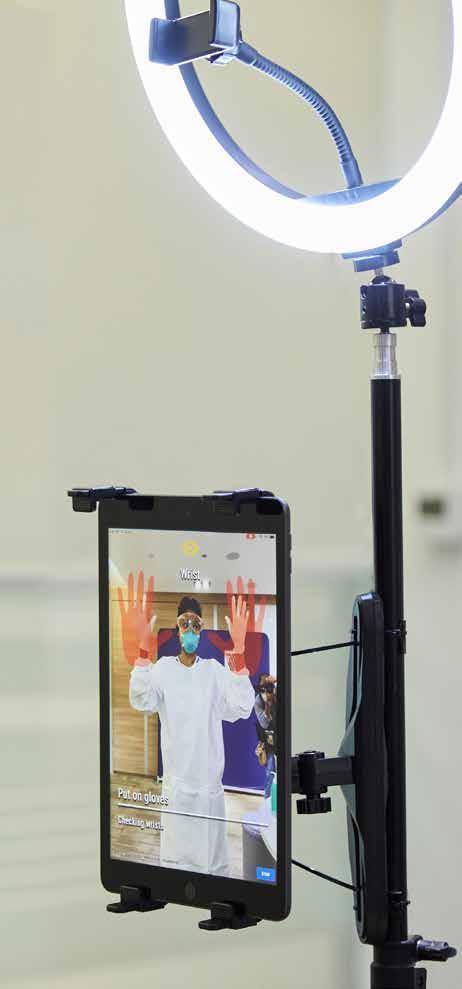
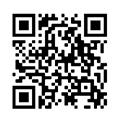
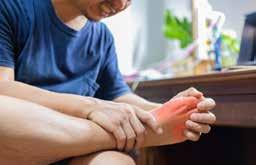



Jan-Feb 2023
MCI (P) 040/07/2022 Receive latest updates via our free electronic mailer. Scan the QR code and subscribe now! Hi-tech staffing solutions Artificial Intelligence and Robotics are helping to relieve manpower crunch in hospitals Read more on page 02 05 InFocus Gout sufferers now have a new resource to help manage their condition 11 People Thriving as an advocate for staff wellness 15 HealthWatch New mums may face hair loss
THE FLAGSHIP PUBLICATION OF THE SINGHEALTH DUKE-NUS ACADEMIC MEDICAL CENTRE
www.sgh.com.sg www.singhealth.com.sg
PUBLISHERS
CO-PUBLISHERS
®
CONTENT ADVISOR Audrey Lau, Jennifer Wee
EDITORIAL TEAM
Lim Mui Khi, Domenica Tan, Jenny Ang, Celine Sim
Read Singapore Health online at www.singhealth.com. sg/singaporehealth
Selected photos featured were taken prior to the COVID-19 pandemic. For all recent photo shoots, safe distancing measures were adhered to.
PUBLISHING AGENT
ThinkFarm Pte Ltd


Managing Director Christopher Tay Head, Content Chua Kim Beng Head, Creative Sean Lee Art Director Lee Lily
Head, Client Relationship Jessie Kek
For advertising enquiries, please call 6831 1299 or email advertise@thinkfarm.sg
All rights reserved. Copyright by Singapore Health Services Pte Ltd (registration no.: 200002698Z). Opinions expressed in Singapore Health are solely those of the writers and are not necessarily endorsed by SGH, SingHealth Group and/or Thinkfarm Pte Ltd (registration no.: 201226362G), and their related companies. They are not responsible or liable in any way for the contents of any of the advertisements, articles, photographs or illustrations contained in this publication. Editorial enquiries should be directed to the Editor, Singapore Health, 168 Jalan Bukit Merah, #13-01 Surbana One, Singapore 150168, or email: singaporehealth@singhealth.com.sg.
Unsolicited material will not be returned unless accompanied by a self-addressed envelope and sufficient return postage. While every reasonable care will be taken by the Editor, no responsibility is assumed for the return of unsolicited material.

ALL INFORMATION CORRECT AT TIME OF PRINTING. MCI (P) 065/08/2021. Printed in Singapore by Times Printers Pte Ltd (registration no.: 196700328H).
Of mirrors and cyborgs
Singapore General Hospital is harnessing the power of AI and robotics to enhance care by freeing staff from the more tedious and strenuous aspects of work.
by Rani Mohan and Goh Bee Lian
Adigital tool is teaching the correct way of wearing protective gear, while a smart harness strapped to a patient with walking issues is enhancing rehabilitation.
Respectively known as Blue Mirror Personal Protection Equipment (PPE) Instructor and Hybrid Assistive Limb (HAL), they are two recent additions to the range of intelligent devices and technology being deployed at Singapore General Hospital (SGH) as it faces the challenges of an ageing population and staff shortage.
The machines also highlight how the hospital is constantly looking for ways to adapt commercially available technology to take over the more tedious, strenuous and repetitive aspects of work. Doing so allows its staff to focus more on providing better patient care.
Mirroring the right steps
When SGH nurses were deployed to the Community Care Facility at the Singapore Expo during the COVID-19 pandemic, donning their PPEs became a daily affair.
Before entering the halls to care for COVID-infected migrant workers, nurses and other staff had to don the full PPE — including the gown, gloves and mask — and check each other to ensure that safety requirements were met. As this took precious time, it soon became apparent that what was needed was a quicker, less labour-intensive, and more

02 CoverStory
Ms
Ang Shin Yuh Deputy Director, Nursing Division, Singapore General Hospital
A nurse instructor takes about 15 minutes to assess the competency of each new staff in donning and doffing the PPE. It can easily take half a day to train 15 new staff. With the Blue Mirror technology, the nurse can focus on patient care or perform other duties.
sustainable solution that did not compromise the safety of the nurses. “This pushed us to think about automating the process using artificial intelligence (AI) and image recognition,” said Ms Ang Shin Yuh, Deputy Director, Nursing Division, SGH.
That led to the development of a new AI-powered digital tool called the Blue Mirror PPE Instructor. When installed on iPads or tablets, the tool acts as a digital mirror that instructs the user through audio prompts and pictorial guides on what to do when putting on and taking off their PPEs. If it detects that gowns and gloves have been worn incorrectly, the tool quickly alerts the user.
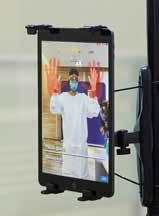


“A nurse instructor takes about 15 minutes to assess the competency of each new staff in donning and doffing the PPE. It can easily take half a day to train 15 new staff. With the Blue Mirror technology, the nurse can focus on patient care or perform other duties,” said Ms Ang, adding that the person need not be supervised and can practise by himself as many times as he likes.
Adopting and customising
Ms Ang mooted the idea to automate the PPE-checking process in 2020. SGH’s Nursing Division took the lead on the project. In November 2021, the hospital partnered New Zealand-based health tech company, Blue Mirror.


“The original Blue Mirror tool had to be customised for local needs and tailored to suit the hospital’s needs, including the types of PPE used,” said Ms Ang. The local version also improved the tool’s accuracy in detecting wrong movements during PPE removal, and the ability to detect surgical masks with visors.

The tool, validated by about 200 staff and visitors, has been deployed in the isolation ward, a multidrug-resistant organism ward, and SGH’s training department. “The tool can be further customised for diseasespecific protocol, contact-tracing purposes and image recognition for staff access. This will put us in a better position should another outbreak occur,” said Ms Ang.
Users can select between three modes.The ‘buddy mode’ is for healthcare workers who are already PPE-trained, and takes less than three minutes. It serves as a quick check to assure staff that they are gowned up safely before entering a patient’s room. The ‘training mode’ is meant for new staff and individuals who do not use PPE on a regular basis. It provides oneon-one sessions, allowing the staff to practise unlimited times without the need for a human trainer. For nonhealthcare workers, the ‘visitor mode’ operates at a slower pace, with step-bystep instructions. Users may also select between four languages — English, Mandarin, Malay and Tamil.
In the Blue Mirror software, users can practise the steps in putting on protective gear without supervision. This removes the need for more senior staff to do these repetitive and tedious tasks.

03
Fewer staff are needed when a patient is using the exoskeleton, which supports the patient and takes over the heavy work done by physiotherapists and assistants in conventional therapy.

Without HAL, patients may need one or two therapists to support them. Strapped to the exoskeleton, the patient is able to walk on her own. This allows the physiotherapist to check how well the patient is progressing.
The Physiotherapy Department is planning to train its therapy assistants to help patients practise their gait with the HAL without the presence of physiotherapists.
Exoskeleton trains gait
SGH started using machines in physiotherapy as far back as January 2013, with earlier gait-training systems. Today, a similar rehabilitation device using more advanced technology, known as the Hybrid Assistive Limb or HAL® Exoskeleton, is being used to rehabilitate patients with reduced muscle strength, impaired coordination, or other mobility issues because of stroke, brain tumours, or spinal cord injuries. When worn by the patient, HAL helps with standing and walking.
“HAL is able to pick up muscle activity from the patients’ legs to augment their movements, thus helping patients who have weak muscle strength in their legs,” said Ms Amanda Lee, Senior Physiotherapist, Department of Physiotherapy, SGH.
When someone intends to move, the brain sends signals via the spinal cord and the nerve cells to the muscles needed for the intended movement. As the signals travel towards the muscles, some ‘leak’ onto the skin. Even in those with disabilities, these very faint bio-electric signals can be detected. HAL uses electrodes taped to the body to detect the signals, then determines the desired movements to help the patient move. Once strapped into the HAL exoskeleton, the patient becomes almost like a cyborg!
Used on a trial basis by SGH physiotherapists since April 2020, HAL is being offered to select patients undergoing conventional physiotherapy. So far, early feedback has been positive, with most of the 40 patients who have used it showing improvements in their walking ability. Anecdotally, some have been observed to begin walking earlier, some with less assistance — with or without an aid — and some have been able to walk longer distances more quickly.
One stroke patient who started on HAL was unable to walk when he first started. While the exoskeleton held him upright to allow him to move his legs, he tended to buckle with each step taken, Ms Lee said. After his 11th session a week later, he did not buckle as much, and was able to swing his legs more easily. He subsequently was able to stand with the help of a cane. “We felt very motivated seeing his progress, as did the patient himself,” said Ms Lee.
Less physical stress on staff “HAL makes it possible to increase the repetition, frequency and guidance compared with conventional therapy, where physiotherapists don’t have as much time to spend with each patient,” said Professor Celia Tan, Senior Director, Special Projects, DGCEO (Medical and Clinical Services) Office, SingHealth.
Patients with mobility issues often need to be held or supported manually during therapy, which also puts physical stress on the therapists and assistants. HAL does not need the patient to be manually supported, so patients can practise walking on their own, taking more steps, and at their own convenience. “We recognise the importance of incorporating equipment into our therapy sessions to maximise the patient’s ability to perform the desired movements while ensuring staff’s safety when assisting the patients to move,” said Ms Lee.
Patients with neurological disorders need intensive, demanding and varied therapy to help them regain their lost functions. Repeating their exercises can also help reinforce and promote motor learning. Compared to the earlier gait-training machine, for instance, HAL is generally much easier to wear and take off. HAL also allows patients to practise walking on the ground, replicating their real life experience, while patients walk on a treadmill with the earlier machine.
Nevertheless, even HAL is limited in its abilities compared to a human therapist.
“At present, machines are not able to assess and identify the deficits in a patient’s movement, thus the physiotherapist’s input is still required,” said Ms Lee.
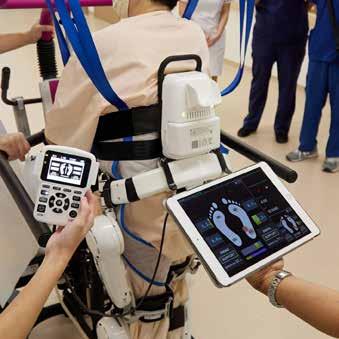
04 CoverStory
SingHealth Polyclinics found that patients were afraid to start treatment for gout due to the perceived high rate of side effects, says Dr Meykkumar S/O Meyappan.


With greater global affluence and the increased consumption of red meat, soft drinks and alcohol, incidences of gout have been on the rise over the years. More than four per cent of adults in Singapore suffer from this complex form of arthritis, which causes severe pain, swelling, redness and tenderness in the joints.
“Despite this rising trend, treatment is not optimised. In a study done by SingHealth Polyclinics (SHP), only 50 per cent of the patients with frequent acute gout attacks were on allopurinol, which is usually the first line of treatment for long-term gout control,” said Dr Meykkumar S/O Meyappan, Associate Consultant, SHP. Patients were also found to have a poor understanding of treatment options.
Shared decision-making
To empower patients to better manage their condition, SHP has developed an information kit, or Patient Decision Aid (PDA), about gout and its treatment options in a clear and concise manner.
It includes a simple infographic comparing treatment options in terms of efficacy, cost and side effects, which sets out the risk of developing rashes, headaches, diarrhoea, vomiting, or kidney and liver issues. It also clearly shows patients the effects of non-treatment or dietary control so that they can weigh their risks when considering these options.
Co-developed by patients and a multidisciplinary medical team through in-depth one-to-one interviews and focus group discussions, this PDA is designed to be used by SHP primary care physicians during consultation with patients.
Managing gout effectively
by Annie Tan
It helps physicians better understand patients’ priorities and concerns, thereby advising them of the most suitable course of treatment. It also enables physicians to easily identify and address any misperceptions patients may have about various treatments, effectiveness and side effects.
One of the benefits of this PDA is that it enables a shift towards a shared decisionmaking process, where patients get to decide on their own treatment option while getting professional advice from doctors. This is a departure from the traditional model, where doctors would usually prescribe treatments.
“The patient is thus more informed and involved in the decision, takes greater ownership over his own health, and better understands the implications of the decision,” said Dr Meykkumar.
Common misconceptions
“A study by SHP found that patients were afraid to start treatment due to the perceived high rate of side effects and their fear of being on long-term medications. Most patients also feel better after the acute attacks subside with painkillers, and do not
see the need to start medications when they feel well,” he said.
Unfortunately, simply relying on a short course of painkillers for pain relief may end up perpetuating the cycle of attacks, especially if gout is poorly controlled.

Indeed, many patients are not aware of the long-term complications of gout and its impact on their quality of life. If gout is not controlled with diet or medication, recurring gout attacks may damage the joint permanently. Patients may develop deposits around the joint called tophi, which further restrict joint movement. They may also develop kidney stones easily.
Non-adherence is another common issue. “We believe that shared decision-making will improve poor adherence towards gout treatment. This approach focuses on the patients’ autonomy so that they will be more willing to accept the treatment because the doctor has taken their lifestyles and concerns into consideration,” said Clinical Associate Professor Tan Ngiap Chuan, Director of Research, SHP, and Vice-chair, Research, SingHealth-Duke NUS Family Medicine Academic Clinical Programme.
A glimpse of an information kit, or Patient Decision Aid, about gout and its treatment options developed by SingHealth Polyclinics.

05 InFocus
Patients can now access concise information and are empowered to have more autonomy to manage gout as doctor-patient communication strengthens.
SINGHEALTH POLYCLINICS
PHOTO:
Creating more mileage for knees
by Dang Hui Ling
Painful arthritic knees are often linked to ageing, but osteoarthritis is increasingly affecting younger people.
A degenerative condition associated with knee malalignment, obesity and sports injuries, osteoarthritis is often treated by taking out the diseased knee bone and replacing it with an artificial part. Someone in his late 30s or early 40s, however, may need to undergo one or even two more replacements, as the artificial parts last at most 20 years.
To avoid having to undergo several replacements — and the possible infections and complications that come with repeated surgeries — younger patients with early arthritis can opt for knee preservation. This involves shaving a bit of the tibia (shin bone) and adding a bone graft to align and distribute the body weight across the whole knee. In arthritic patients, their body weight tends to shift to one side, causing pain and sometimes, bow legs..
“A preservation surgery not only addresses patients’ knee osteoarthritis problem, but may also help them delay or even avoid the need for a knee replacement surgery in the future,” said Dr Lee Kong Hwee, Consultant, Department of Orthopaedic Surgery, and Director, Sport Service, Singapore General Hospital (SGH).

Data show that 80 per cent of patients who had undergone a type of preservation surgery known as high tibial osteotomy (HTO) did not need a knee replacement 10 years after the surgery, Dr Lee added. “Should the arthritis advance for whatever reason, the patient can still go for a replacement; that bridge is not burnt,” said Dr Lee, who also spearheads SGH’s Knee Preservation Service, which was set up in 2019.
In Singapore, more than 10 per cent of adults suffer from knee osteoarthritis. At SGH, some 150 people have undergone knee preservation surgery from the start of the service to end-2021. A third of SGH’s knee osteoarthritis patients suffer from medial compartment osteoarthritis, where patients
Mr Liu Syn Thye, 67, was the first patient to undergo PFO at SGH in October 2020. Before the surgery, he was given injections at a private clinic every two weeks to ease the pain in his right knee.

He was reluctant to go for a knee replacement surgery, as he had undergone two heart bypass surgeries previously.
Mr Segar Sivanasen, 44, had a lot of pain in the inner right knee. He underwent high tibial osteotomy involving a small 6mm cut to centre his body weight, and is now able to resume activities like running.
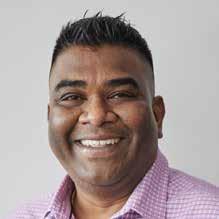

usually only feel pain in the inner part of the knee when the thigh and shin bones rub against each other. Wear-and-tear thins the cartilage, which no longer acts as a cushion at the joint.
HTO is one of the more common techniques used at SGH on younger patients, typically between 40 and 60 years of age. In this procedure, a wedge-shaped opening in the upper portion of the shin bone is made, then a bone graft wedge is inserted and secured with a titanium plate and screws to align the knee. Pressure is taken off the damaged portion of the knee joint, allowing the body weight to be distributed more equally on the knees.
Another method is proximal fibular osteotomy (PFO), which — because of the short recovery time required — can also be

offered to patients older than 50 years, and those with severe skin dermatitis, poorly controlled diabetes and poor immunity.
In PFO, 2cm of the patient’s calf bone is removed to disconnect the support to the outer part of the knee, allowing for equal distribution of weight across the entire knee joint. Patients can walk after surgery and are discharged on the same day. Full recovery takes about two weeks.
Both HTO and PFO are less invasive, more precise and have a lower risk of infection than conventional knee replacement. HTO can be performed on patients whose knees are severely bent or curved, and correction is immediate. PFO is not recommended for patients whose knees are severely bent or curved, and correction is achieved gradually over a year.
surgery to “an extension of the knee’s COE (Certificate of Entitlement)”, and the procedure to rebalancing of car tyres whose treads have become worn on one side after some time. With preservation surgery, or osteotomy, the weight of the body is shifted to the centre of the body instead of on one side.
06 InFocus
For younger patients with knee osteoarthritis, new treatment options are available to preserve rather than replace the knees.
PHOTOS: VERNON WONG
Dr Lee Kong Hwee likens preservation
Reversing heart muscle scarring
by Sol E Solomon
In Singapore, the prevalence of hypertension has increased from 24.2 per cent in 2017 to 35.5 per cent between 2019 and 2020. It is a major cause of heart disease caused by narrowed heart arteries as well as stroke and heart failure.

A study in Singapore has conclusively proven for the first time that myocardial fibrosis (scarring in the heart muscles) predicts worse outcomes in patients with hypertension (high blood pressure). The National Heart Centre Singapore (NHCS) study, titled REMODEL (Response of the Myocardium to Hypertrophic Conditions in the Adult Population), sets the stage for another ongoing trial (REVERSELVH) that such scarring can be reversed through customised treatment.
High blood pressure creates stress to the heart. Initially, the heart can cope with this added stress. However, over time, the sustained stress causes the heart muscles to thicken, leading to heart muscle scarring, said Assoc Prof Chin, who is also Director of Cardiac MRI at NHCS. Because myocardial fibrosis reduces contraction of the heart, it can lead to heart failure or even death.
“Although anecdotal reports have previously shown the presence of heart muscle scarring in patients with hypertension, this is the first study that confirms the association between scarring of heart muscle and cardiovascular outcomes in patients with hypertension,” said Assoc Prof Chin. “We found that heart muscle scarring is a strong predictor of adverse outcomes even after taking into consideration patients’ age, sex and systolic blood pressures.”
patients is varied. While two patients may have similar blood pressures, their heart muscle characteristics can differ. This presents opportunities to personalise treatment for hypertensive patients who have heart muscle scarring to reduce the risk of future cardiovascular events.
Although conventional medical treatment is able to control one’s blood pressure, it does not completely eliminate the risks of cardiovascular disease. For instance, about 30 per cent of cardiovascular events occur in patients with well-controlled blood pressure.
This is the first study that confirms the association between scarring of heart muscle and cardiovascular outcomes in patients with hypertension, says Associate Professor Calvin Chin.

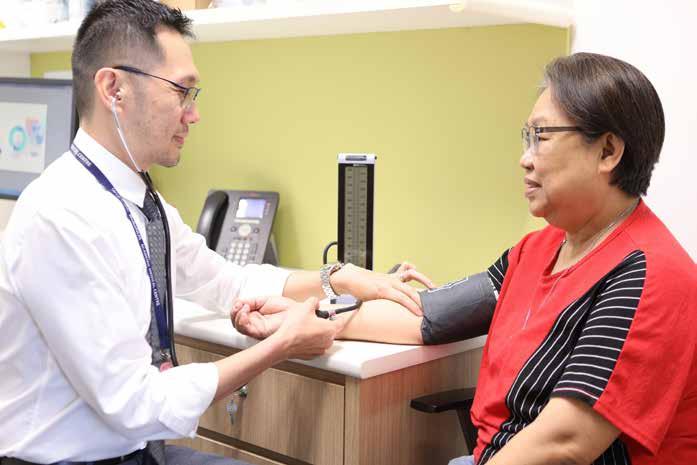
Instead of the traditional way of detecting scarring through heart muscle biopsies, REMODEL employs the use of noninvasive cardiac magnetic resonance imaging (CMR), also known as cardiac MRI. CMR was performed on close to 800 patients with hypertension. Led by Associate Professor Calvin Chin, Clinician Scientist and Senior Consultant, Department of Cardiology, NHCS, the patients were followed up for adverse cardiovascular events over a period of more than three years.
Encouraging results
Myocardial fibrosis typically happens in patients who have previously suffered from heart attacks, so only patients without a history of heart attacks were selected for the study. This confined the occurrence of myocardial fibrosis to factors such as the patient’s susceptibility to high blood pressure, genetic predisposition and medical co-morbidities such as diabetes.
The researchers found that the heart muscles’ response to hypertension in
REVERSE-LVH examines the potential of reversing heart muscle scarring through the use of specific therapies targeted at fibrosis in patients with hypertensive heart disease. It also compares the efficacy of medications in regressing myocardial fibrosis. Recruited patients undergo CMR at the beginning of the study and after a year of treatment to assess changes in the amount of myocardial fibrosis. “What is encouraging about the results is that we are seeing evidence of reversal for the first time,” said Assoc Prof Chin. Even after their heart muscles are normalised following the tailored treatment, patients in the study are encouraged to continue with the prescribed medications.
Research candidate
Mdm Josephine Tan (not her real name), who is in her 60s and a patient with hypertension, participated in REVERSELVH. “I am fortunate that I went for the CMR, otherwise I would not have found out that I have this serious heart condition,” Mdm Tan said, adding that the CMR has given her a “second chance at life”.
07 InFocus
A study has shown a relationship between heart muscle scarring and hypertension.
Mdm Josephine Tan feels fortunate to have participated in the REVERSE-LVH study because it led to the discovery of a serious heart condition in her.
No more dry eye
condition from worsening, as peri- and postmenopausal women with dry eye issues tend to be associated with systemic conditions including insomnia, indigestion, emotional stress and anxiety, irritable bowel syndrome and not just local dry eye deficiency alone,” said Dr Pat Lim, Chief Physician and Board Vice Chairman at SCHMI, and the Principal Collaborator for this study. She is also Head of SCHMI’s TCM Ophthalmology Department.
In a study completed in 2017 by SERI and SCHMI, 15 dry eye participants were prescribed a lubricating eye gel and administered with eight sessions of acupuncture over four weeks (variable group), while another 15 participants used only the eye gel (control group). Sixty per cent of the participants in the variable group were found to have an increase in supportive proteins and a decrease in inflammatory proteins. On the other hand, only 27 per cent in the control group showed equivalent patterns of protein change. Based on these encouraging results, the current clinical trial has been expanded to study 150 peri- and post-menopausal women with symptoms of dry eye.
While dry eye is also prevalent in younger people, they are often non-systemic and attributable to environmental factors, such as prolonged screen time, exposure to air-conditioning, insufficient sleep or improper diets. These factors may be resolved without medication by making the necessary lifestyle changes.
Dr Pat Lim (left) says that applying TCM on dry eye patients — the majority of whom have a mild to moderate form of the condition — can help keep treatment cost and care affordable.

Professor Louis Tong (right) adds that while conventional prescription drugs for dry eye such as cyclosporine and corticosteroids are likely to benefit periand post-menopausal women, they are not always effective as they do not address the underlying hormonal problems.
Aclinical trial by Singapore Eye Research Institute (SERI) and Singapore Chung Hwa Medical Institution (SCHMI) is recruiting peri- and post-menopausal women to evaluate the efficacy of traditional Chinese medicine (TCM) remedies for treating dry eye.

Studies done in the United States recorded the rate of dry eye disease in women over 50 years of age to be nearly double that of men in the same age group. This could be due to the hormonal changes
by Goh Bee Lian
experienced by women during and after menopause that are systemic conditions associated with dry eye.
TCM as a treatment for dry eye is not widely known. In reality, TCM practitioners in Singapore have been using herbal medication and acupuncture to treat dry eye for over 20 years. Other TCM treatment methods for dry eye include the use of warm eye masks, eye steaming, eye spa, as well as scraping, massage and moxibustion around the eye.

“The majority of patients with dry eye in Singapore have a mild to moderate form of the condition. Treating this group of patients in the primary care settings and holistic treatments like TCM help to keep treatment cost and care affordable. It also prevents the patients’
“We see a significant number of periand post-menopausal women who are very symptomatic. About 70 per cent of patients are women and more than half are above 55 years old. Such patients are likely to benefit from conventional prescription drugs for dry eye such as cyclosporine and corticosteroids, but these treatments are not always effective because they do not address the underlying hormonal problems. We see an opportunity to employ new therapeutic modalities, such as TCM, to treat dry eye in these women,” said Professor Louis Tong, Principal Clinician Scientist and Head of the Ocular Surface Research Group, SERI, and Senior Consultant, Corneal & External Eye Disease Department, Singapore National Eye Centre.
Earlier research by SERI has led to standardisation of the acupuncture procedure and the development of a herbal supplement named Qi Ju Gan Lu Yin (杞菊 甘露饮) that can provide better therapeutic effects for dry eyes. Chrysanthemum, goji berries and baby ginseng are among the 11 ingredients in the supplement, which has been approved by Health Sciences Authority and is available for purchase at SCHMI.
From now till 31 August 2023, the clinical trial is recruiting 150 peri- and post-menopausal women between 40 to 79 years old with symptoms of dry eye such as eye irritation, burning or tearing. Those interested in participating in this trial of herbal medication for treating dry eye can email SERI’s research office at res.recruit@seri.com.sg or contact SCHMI at 6877 4203 or 8424 0546 (9am–5pm, Monday–Saturday).
08 InFocus
Clinical trial shows encouraging results in TCM treatment for dry eye.
Dr Pat Lim treating a patient with dry eye symptoms using acupuncture.
Say NO to abuse
by Annie Tan
The patient at Singapore General Hospital’s (SGH) emergency department (ED) was becoming increasingly agitated and aggressive. He began shouting and threatened to kill himself. Assistant Nurse Clinician Mohamed Ridzuan Sulaiman tried to calm him down, but the patient suddenly picked up a glass bottle of cough syrup.
Mr Ridzuan knew it was time to trigger the hospital’s Code White.
Like the more well-known Code Blue (for a sudden cardiac arrest), Code White is an emergency signal to alert the hospital’s team of four male nurses and two security officers that a colleague needs support in a potentially dangerous situation.
“The objective is to de-escalate violent cases. If our security officers are not able to resolve the issue, the situation may then have to involve the police,” Mr Ridzuan said, adding that staff can text or use the public address system to call for the Code White team when faced with verbal, physical or sexual abuse.
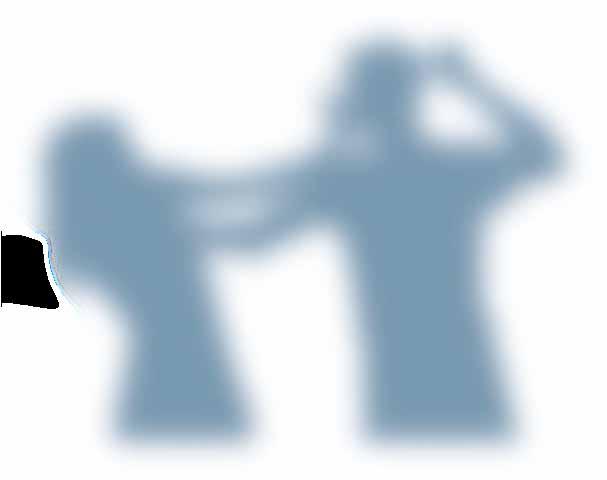
Abusive incidents are not uncommon in hospitals, but the number of cases appeared to have increased during the COVID-19 pandemic, especially at the ED, where tempers tend to run high due to the usually crowded room and long wait time. It is also common for staff to have to deal with patients who are drunk, raise their voices,
hurl vulgarities, throw things at people around them, threaten other patients and demand food or immediate medical attention. Some refuse to be examined and are uncooperative during consultation, while others touch nurses inappropriately.
Between January and August 2022, 48 verbal and physical abuse cases were reported at the ED, compared to 55 between 2019 and 2021. In 2019, a team of ED nurses came together to work on the Code White project, which won the Singapore Health Quality Service Best Team Award for 2022. The Code White framework sets out clearly what constitutes abuse, and how to handle and de-escalate violence in a quick and safe manner. “Patients raising their voices, using vulgarities or creating a commotion are early signs of aggression. If they are not addressed promptly, the situation can escalate quickly and result in physical injuries,” Mr Ridzuan said. He has been punched in the stomach by a patient, while a colleague was hit so hard in the face that his spectacles and face shield broke.
To empower and give nurses and staff at SGH’s ED confidence in managing abusive situations, they are encouraged to attend an hour-long Code White training session to assess, prevent and manage violent and aggressive situations. Being able to manage such situations ensures the safety and respectful treatment of staff and patients alike.
In the past, most of the staff were reluctant to report abuse, citing reasons such as accepting violence and abuse as part of the job. “When a patient hits them, many staff just let it pass,” said Mr Ridzuan, adding that they also feared getting reprimanded, not getting support or not knowing how to report abuse. The reporting process has been simplified and takes less time, thus encouraging more to report abuse. Having this data provides the hospital with a more accurate picture of what is happening on the ground.
“Abuse makes healthcare work more physically and mentally exhausting. It also affects the quality of care for other patients. The Code White initiative creates a more conducive environment, boosts morale, reduces burnout among healthcare workers and improves patient well-being,” said Mr Ridzuan.
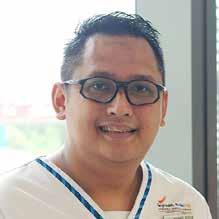
Besides Mr Ridzuan, the Code White team includes Senior Staff Nurses Seah Hwee Ling, Maureen Lee Kai Yi, Nurul Iffah Mansor, Tay Kok How, Siti Nurhalizah Kamis and Lee Guan Teck; Principal Enrolled Nurse Anthony Chandren; Senior Patient Care Assistant Ariss Selamat; and the Security Department’s Senior Associate Executive Muhammad Fadhil Mohamed Zin. Nowretired Nurse Clinician Norizan Jaafar led the team on the project.
says the Code White initiative creates a more conducive environment, boosts morale, reduces burnout among healthcare workers and improves patient well-being.
09 InFocus
An initiative called Code White reduces abuse within the emergency department, and enhances the safety and well-being of healthcare workers and patients.
InFocus
Assistant Nurse Clinician Mohamed Ridzuan Sulaiman
First and only choice
by Goh Bee Lian
Nursing was the first and only choice for Advanced Practice Nurse (APN) Cynthia Lim when picking a polytechnic course to pursue after her GCE ‘O’ levels.

“I love that nursing is a job where I can meet and help different people every day,” said Ms Lim, who is also a Senior Nurse Clinician in the Children’s Emergency (CE) at KK Women’s and Children’s Hospital (KKH).
She was successful in her application for a scholarship from KKH. Upon completion of her three-year diploma studies at Nanyang Polytechnic in 2005, she joined the hospital as a Registered Nurse (RN) in Paediatric Oncology before being transferred to the Paediatric medical wards.
The CE at KKH opened in 1997, and is Singapore’s first and largest emergency facility equipped to treat all conditions for children. About 100 nurses work alongside the doctors at KKH’s CE to manage 400 to 500 attendances per day, providing care to paediatric patients up to 18 years of age. Mostly RNs, the nurses undergo an emergency medicine nursing core training programme that equips them to perform a variety of tasks, such as triaging, resuscitation and physical assessment of a child who is sick or whose condition may be deteriorating.
“All hospitals have emergency departments and they are equipped to stabilise critically ill patients, including children. In the event that the child requires further treatment and hospitalisation, they would then transfer the patient to a hospital specialising in paediatrics for continuity of care.”
Although the CE handles many emergency cases, critical cases such as those involving traffic accidents, falls from heights and respiratory distress form the minority.
Ms Lim and her colleagues at the CE see their share of non-critical cases during regular days, but the numbers tend to spike during weekends and public holidays when general practitioner (GP) clinics are closed. “For instance, during the lunar new year holidays before the COVID-19 pandemic struck, the CE attendance for a day doubled,” she shared.
for advice. Ms Lim is part of the development team of U-PAL.
Throughout her career, Ms Lim has continually sought to upgrade her professional skills, obtaining a Diploma in Nursing in 2005, an Advanced Diploma in Nursing in 2009, a Bachelor of Science (Nursing) in 2012 and a Master of Nursing in 2014. She obtained her APN licence in 2015 after passing a oneyear internship.

Since becoming an APN, Ms Lim’s responsibilities have expanded beyond the bedside care and predominantly routine work of an RN. Nowadays, a typical day sees Ms Lim working in collaboration with the care team to handle resuscitation cases during an emergency.
Apart from that, she also performs follow-up video consultations for patients whose condition is stable and who have been discharged from the department, together with a consultant and another APN. The video consultation service, piloted in 2020, has since expanded to be offered four times a week, offering patients the convenience of a medical consultation without having to travel to the hospital.
Advanced Practice Nurse and Senior Nurse Clinician, Children’s Emergency, KK Women’s and Children’s Hospital
For infants less than a year old, parents are strongly advised to take the child for prompt assessment by a medical professional such as a GP or at a hospital. In cases where they are unsure whether to take their sick child to a CE, Ms Lim recommends that they first use the KKH Urgent Paediatric Advice Line (U-PAL) at www.kkh.com.sg/upal
On top of her clinical duties, she leads the APN internship programme, overseeing the progression and performance of APN interns. Upholding the nursing standards, she shares training responsibilities with the senior nursing team to facilitate simulation and code activations for nurses.
A running enthusiast, Ms Lim goes for a jog two to three times a week to keep fit and recharge. The mother of two girls, aged six and seven, often visits parks and playgrounds, where she spends quality time with her family while enjoying the outdoors.
10 People
Ms Cynthia Lim’s passion to serve drew her to the nursing profession.
Ms Cynthia Lim
I love that nursing is a job where I can meet and help different people every day.
Helping thriveemployees at work
and uncertainty resulting from a constantly changing situation.
“As healthcare workers, our sense of mission to protect our community against the pandemic is very strong. However, as the stress and anxiety, both at work as well as home, built up over a prolonged time, some healthcare workers began to struggle and feel distressed,” said Assoc Prof Phua.
To tackle such issues and strengthen the organisational culture for staff wellness, he and his team employed a systematic approach to understand employees’ needs.
They set up a Staff Wellness Council to integrate the best practices and insights to support staff wellness. The Council includes institutional leaders and professional group representatives such as doctors, nurses, allied health professionals, administrative, as well as subject-matter experts like psychologists and medical social workers.
With over two decades of experience as a Senior Consultant at the Singapore General Hospital’s (SGH) Department of Respiratory and Critical Care Medicine, Clinical Associate Professor Phua Ghee Chee knows first-hand how a heavy workload and hectic work life can take a toll on one’s mental health.
“Many times in my career, I have felt physically, mentally and emotionally exhausted, and this experience rings true to many healthcare workers, especially so when the COVID-19 pandemic struck,” he said. “There was a lot of responsibility on my shoulders, leading the pandemic ICU response. It was so difficult taking care of patients, colleagues, family and myself at the same time,” he shared.
After a colleague expressed concern that he seemed “joyless” at work, Assoc Prof Phua realised that he was experiencing burnout and decided to pluck up the courage to speak to a counsellor.
“Healthcare workers often expect ourselves to
(Hospital Experience)
Senior Consultant, Department of Respiratory and Critical Care Medicine
Singapore General Hospital
by Elena Owyong
be ‘invincible’ and we find it so difficult to ask for help.” He credits counselling for improving his mental well-being and selfcare skills. This helped him to better cope with stress and uncertainty.
Assoc Prof Phua holds a concurrent appointment as the Deputy Chief Executive Officer at SGH, in addition to his clinical and academic appointments.

In April 2022, Assoc Prof Phua was appointed as SingHealth’s Group Director of Staff Wellness, where he spearheads initiatives to promote staff wellness and make it central to the organisational culture. He sees this appointment as a great opportunity to emphasise SingHealth’s priority on staff wellness, an issue that is particularly important to healthcare workers.
“You cannot pour from an empty cup. Healthcare workers give a lot of themselves to patients. Therefore, it is even more important for healthcare workers to take care of themselves so that they have the capacity and empathy to care for others.”
Burnout is not a new issue among healthcare workers, Assoc Prof Phua said. However, he recognised that the pandemic resulted in an escalation of burnout and fatigue in the healthcare sector. This was contributed by increased workload, social isolation, loss of control
According to Assoc Prof Phua, the first step to fostering a culture of staff wellness lies in defining wellness and why it is important. The Council has developed five key pillars:
• physical health
• mental health and well-being
• building community and camaraderie
• positive culture and values
• career and workplace well-being
The newly formed Council is strengthening the peer support network among different groups of staff so that those who face difficulties can approach their peers for emotional support. Beyond that, the Council is also looking to streamline work processes so that staff can focus on patient care, among other initiatives.
In the course of his work, it is important that Assoc Prof Phua understands what matters to his colleagues. “The conversations we have on staff wellness should not be a top-down approach. Individuals must be aware of how they can alleviate their stressors as there is no one-size-fits-all solution,” Assoc Prof Phua shared.
Outside of work, Assoc Prof Phua has a self-care ritual that he practises regularly. This includes running, gratitude journaling and mindfulness-guided meditation. He often volunteers with his family and golden retriever at Animal-Assisted Interaction Singapore to promote well-being and bring joy to those around.


11 People
As the Group Director of Staff Wellness, Assoc Prof Phua Ghee Chee believes that it is essential to empower staff to prioritise their well-being.
Clinical Associate Professor Phua Ghee Chee Deputy Chief Executive Officer
Healthcare workers often expect ourselves to be ‘invincible’ and we find it so difficult to ask for help.
Assoc Prof Phua with his golden retriever at some of Animal-Assisted Interaction Singapore’s outreach events.
Faulty gene
On Rare Diseases Day on 28 February,

 By Goh Bee Lian, with information provided by Associate Professor
Goh, Senior Consultant, Department of Gastroenterology and Hepatology, SGH
By Goh Bee Lian, with information provided by Associate Professor
Goh, Senior Consultant, Department of Gastroenterology and Hepatology, SGH
Wilson’s disease is due to an inherited defect in the ATP7B gene, which causes copper to accumulate, mostly in the liver and brain. Small amounts of the mineral is needed to stay healthy, but too much can result in brain damage, liver failure or even death.
It is a recessive genetic disorder where both parents must pass on the same abnormal ATP7B gene even if they themselves do not have signs of the disease. People with a family history of Wilson’s disease, especially so-called first-degree relatives like parents or siblings, have a higher chance of getting it. Once it is diagnosed, family members will be asked to check for the disease too.
Telltale signs
Signs of the disease manifest in various organs, usually appearing only when copper has built up in excessive amounts, mostly in the liver, eyes, brain and the central nervous system.
Liver symptoms Inflammation that can lead to cirrhosis (scarring) and liver failure

Water retention
Fatigue
Poor appetite
Treatment
A diet comprising low-copper foods
Jaundice with yellowing of skin and whites of eyes, darkcoloured urine
Central nervous system symptoms Stiff or weak muscles, tremors or uncontrollable movements
Problems relating to speech, swallowing and coordination


Kayser-Fleisher rings, where green-brown rings surround the corneas
Behavioural changes and psychiatric issues

12 AtAGlance
we look at Wilson’s disease. Early diagnosis and treatment of the genetic disorder can help prevent serious long-term disability and life-threatening complications.
George
1 in
people may
90
be carriers of the disease gene
Medications to help remove copper from the body, prevent copper absorption from the intestines
Chocolate Liver Nuts Multivitamins containing copper Shellfish
Dried fruits
Occurs in estimated 1 in 30,000 but 2013 UK study with gene testing suggests 1 in
Avoid consuming these high-copper items Who can get it? Family history, especially if parents or siblings have the disease
Mushrooms
Urine Shows up mostly between 5 and 35 years of age Affects men and women equally
7,000
Salt intake rising in Singapore
Salt consumption among Singaporeans has increased tremendously. Findings by the 2018/2019 National Nutrition Survey conducted by the Health Promotion Board revealed that 90 per cent of Singaporeans consumed 9g of salt daily on average, which is well above the recommended amount of 5g per day.
According to Ms Ong Li Jiuen, Head, Dietetics, Changi General Hospital (CGH), the reason behind the significant rise in salt intake can be attributed to the growing trend of people eating out more often due to busy lifestyles. “As a result, most may opt for convenience by choosing easy-toprepare processed food, which are often high in sodium,” she said.
 by Puvanes Balakrishnan
by Puvanes Balakrishnan
and muscular functioning, as well as the regulation of water and mineral levels in the body.
However, excessive salt consumption can lead to detrimental consequences to one’s health. “Consuming high levels of salt over a period of time can result in health conditions such as high blood pressure, heart diseases, stroke and depletion of calcium stores in the body, leading to thinning bones, which poses a risk of osteoporosis,” shared Ms Ong.
• Include more fresh fruits and vegetables in your diet as these are low in sodium and contain sources of other minerals such as potassium, which together with sodium supports fluid balance in the body that in turn helps regulate blood pressure levels.
the rise in salt intake to people eating out more frequently due to busy lifestyles.

Also known as sodium chloride, salt comprises 40 per cent sodium and 60 per cent chloride, and is the primary source of sodium and chloride ions required to maintain optimum health. Being a vital electrolyte and naturally occurring mineral, salt is necessary for proper nerves
Healthier SG is aimed at helping Singaporeans take steps towards better health. The programme enables Singaporeans to know their chosen family doctor, who will provide care for them, learn about preventive care steps to improve health, including nationally recommended vaccinations and free health screenings for six types of chronic conditions and cancer.
Conversely, it is just as possible to experience sodium deficiency if one loses too much sodium as a result of strenuous activities. Extremely low levels of sodium can potentially lead to a dangerous condition called hyponatraemia. This condition, caused by the extreme loss of sodium, can trigger symptoms ranging from muscle cramps, nausea, vomiting and dizziness to shock, coma and death. Consuming electrolyterich beverages to compensate for the loss of sodium and other essential minerals from the body can help prevent these scenarios from occurring.
Ms Ong recommends the following tips to strike a balance when it comes to salt intake: • Prepare your own meals. This allows you to adjust your sodium intake accordingly. Natural herbs, spices and aromatics such as onion, ginger, garlic, chilli, parsley, spring onions, cinnamon and pepper are common alternatives that enhance the taste and aroma of food while reducing the need to add too much salt or seasoning.
• Consume fresh instead of processed or cured meats such as ham or bacon, which contain higher levels of sodium used to preserve the meats and maintain their freshness for longer periods of time. Fresh cuts of chicken and beef naturally do contain sodium, but their levels are significantly lower compared to processed meats.
• Read nutrition labels on food items and look out for the sodium content on the Nutrition Information Panel (NIP). The amount of sodium is listed under the ‘per serving’ column on the NIP. Be mindful of servings, though, as exceeding the recommended number of servings can still lead to an increased sodium intake.
However, with Singaporeans dining out more, how then does one ensure a healthy salt intake? Ms Ong suggests some simple reminders that include:
• Opting for plain rice instead of flavoured rice.
• Declining or asking for less salt, sauces and gravy.
• Choosing rice noodles such as bee hoon or kway teow, instead of yellow noodles, which are likely to contain more sodium.
• Tasting food first before adding more sauces and condiments such as chilli sauce, ketchup or soy sauce.
While salt should be consumed sparingly across the board, people with particular health conditions have to be more careful with their salt intake. “For those with high blood pressure, excess salt in the diet increases the risk of stroke, kidney disease and heart diseases. As for those with renal issues, too much salt may result in extra sodium and fluid build-up in the body, leading to swollen ankles, puffiness and a rise in blood pressure, shortness of breath and fluid around the heart and/or lungs,” said Ms Ong. Fluid overload is also commonly seen among those with heart problems, as the heart muscles do not pump blood as optimally as they should.
13 HealthWatch H e a lthierSG
People eating out more is contributing to this trend, but moderating salt intake is important to maintain good health.
Ms Ong Li Jiuen, Head, Dietetics, CGH, attributes
On the move, quicker
Those who frequently squat or run, such as childcare teachers, cleaners and sportsmen, are most at risk of osteoarthitis, says Dr Francis Wong.
 by Sol E Solomon
by Sol E Solomon
Patients with early kneecap osteoarthritis and knee pain due to holes in the knee cartilage need about two months before they can fully regain mobility after traditional open knee surgery, and for active patients, a year before they can start running. But a new keyholebased procedure available at the Sengkang General Hospital (SKH) now shortens this time by half.
Cartilage is tissue that lines bone surfaces. It protects joints from stress by providing a smooth surface so bones can move against each other well. Osteoarthritis causes the cartilage in the knee joint to become thin and lose quality. As the cartilage wears out, holes form in the knee, causing pain, stiffness and reduced mobility. Those who frequently squat or run, such as childcare teachers, cleaners and sportsmen, are most at risk.
In early osteoarthritis, especially that of the patellofemoral region (kneecap), patients will feel pain when climbing stairs, said Dr Francis Wong, Consultant, Department of Orthopaedic Surgery, SKH. “The front or side of the knee aches. Next, the knee swells because the cartilage is not in its optimum condition, and more fluid builds up to increase the cushioning,” he said.

Another cause of early osteoarthritis, other than wear and tear of the cartilage,
may be due to injury that causes the shock absorber of the knee, called the meniscus, to tear, resulting in pain.
During diagnosis, x-rays of the bones are taken to determine the severity of the arthritis and also to check for alignment of the knees. An MRI scan is also done to establish the sources of the defect, the location of the hole that is affecting the knee and how severe the condition is.
Initial treatment of osteoarthritis is conservative. Apart from physiotherapy to strengthen their thigh muscles, patients are advised to make lifestyle changes, such as to lose weight or modify their sporting activities by reducing intensity, or change their sport of choice. They may also be given medications and injections.
Operating table
Surgery is recommended as the last resort, or when the pain persists despite other measures.
During the operation, bone marrow is taken from the tibia below the patient’s injured knee. The marrow is then used to activate a synthetic piece of filler called a “scaffold”, which provides an environment that supports tissue growth, thus enabling the cartilage to re-form.
In conventional open knee surgery for kneecap osteoarthritis, the scaffolds are inserted into the knee and patients are then put on a knee brace for six weeks, during which they will require the use of crutches or frames. Due to its large size, the wound takes two to three weeks to heal. The joint

eventually gets stronger and patients should be able to walk normally in about eight weeks. Open surgery is normally required to insert the scaffold for kneecap lesions due to their location, making keyhole surgery difficult. This leads to the large wound in the front of the knee, which then leads to a longer duration of recovery.
With the keyhole method, or arthroscopy, that SKH is pioneering in Singapore for early kneecap osteoarthritis, two small cuts, each less than 1cm in length, are made on either side of the knee. One cut is used to introduce the scaffolds into the knee; the other cut is where a camera is inserted during surgery for the surgeon to see the inside of the joint on a TV monitor. Patients stay in the hospital for two days, their wound heals in 10 days, and they are are able to start walking normally in three to four weeks. When they return home, patients are provided with an exercise regime based on their physiotherapist’s recommendations. They then receive followup physiotherapy every fortnight.
Recovery time for such patients is much shorter than via conventional surgery.
“They are moving around very well in three to four weeks, so they can take the brace out early,” said Dr Wong, adding that active patients who undergo keyhole surgery can usually go back to running in six months.
“We advise patients to seek help early when they realise that squatting hurts, or if knee pain lasts for more than two weeks. The earlier we detect the condition, the better we can provide solutions.”
14 HealthWatch
Keyhole procedure for cartilage repair provides greater convenience to patients with early kneecap osteoarthritis
Why new mums lose their hair
New mothers who lose excessive amounts of hair usually get back their crowning glory by the time they are celebrating their baby’s first birthday.
 by SK Lim
by SK Lim
New mums may notice that they are losing more hair than normal, with some even detecting bald patches. However, they should not worry: for most, post-pregnancy hair loss is natural and temporary.
Caused by a variety of reasons, including changes in hormonal levels, telogen effluvium or more commonly known as postpartum hair loss affects half of all new mothers.
mothers may find that they can lose as many as 300 strands of hair daily. “The total volume of hair loss probably is not more than what one would have lost over the preceding nine months, but it just feels like a lot more because it’s happening all at once,” said Dr Tan.
Postpartum hair loss is caused by a variety of reasons, including changes in hormonal levels, says Dr Tan Wei Ching, Senior Consultant, Department of Obstetrics and Gynaecology, Singapore General Hospital.


“Postpartum hair loss is usually self-limiting, and most new mothers will notice complete restoration of normal hair patterns by six to 15 months after birth, back to the pre-pregnancy state,” said Dr Tan Wei Ching, Senior Consultant, Department of Obstetrics and Gynaecology, Singapore General Hospital (SGH).
Hair goes through growth and rest periods. However, after delivery, the woman’s oestrogen hormone levels fall, triggering a lengthening in the resting period. The hair that falls out a few weeks later is noticeable. Instead of the 100 strands that a person typically loses a day, new
Postpartum hair loss, in the absence of other medical causes, is rarely permanent. However, should the hair loss be permanent or the return to normal hair growth be delayed, new mothers are advised to see a doctor to ensure that there are no other underlying conditions, such as severe anaemia or thyroid disorders. People can lose hair for many reasons, and an accurate diagnosis is essential for effective treatment.
Not all mothers will experience postpartum hair loss, while some mothers experience it in one pregnancy but not another. Besides the drop in oestrogen levels, other factors — such as poor health, stress, genetics, diet and medications — can affect hair loss to different extents. “Every ethnicity has different hair types and, hence, different rates of hair loss as reported by various nonmedical resources,” said Dr Tan.
To help the restoration process and make postpartum hair loss less noticeable,
new mothers should keep their hair healthy by maintaining a well-balanced diet. Postpregnancy, women should be gentle when washing, brushing and styling their hair. They should avoid pulling their hair tight, tying it up, or even using hairdryers, so as not to put extra strain on the scalp. They should also minimise chemical hair treatments, including colouring, perming and straightening.
However, this does not mean that hair grooming should be neglected. “All new mothers can pamper themselves with a haircut to make their hair appear fuller, and help expedite hair regrowth. They can also consider using volumising shampoos and lightweight conditioners to make their hair appear less limp,” said Dr Tan.
Some women may be tempted to take preventive measures during their pregnancy, such as taking prenatal vitamins or health food supplements. “Unfortunately, there is no evidence to show that these measures can prevent or slow postpartum hair loss. But there is no need to despair, as most new mothers notice complete restoration of hair growth by their baby’s first birthday,” she added.
15 HealthWatch
Ingredients
• 500g lean mutton loin, sliced
• 1tbsp oil
• 11/2 g belacan (dried shrimp paste)
• 1tsp salt
• 900ml water
• 30g chilli paste

• 100ml low fat yoghurt
• 1tbsp light soy sauce


• 50g onion, sliced
• 3 red chillies, each cut into 3
• 3 green chillies, each cut into 3
Blend
• 80g shallots
• 3/4 thumbsize piece of ginger
• 6 cloves garlic
• 2 candlenuts
• 100ml water
Method
1 Heat oil and add blended paste. Fry till fragant.
2 Add mutton, belacan, salt and water.
3 Boil for 45 minutes or until mutton is tender and cooked. Depending on the meat, this could take twice as long.
4 Add chilli paste, low fat yoghurt and light soy sauce. Boil to reduce the liquid by half.
5 Add sliced onion and chillies
6 Simmer for a further 10 minutes till onion and chillies are cooked.
7 Remove from heat and serve.
Estimated nutrient content (per serving) Energy 283kcal Carbohydrate 10g Protein 27g Fat 15g Sodium 913mg Cholesterol 100mg Mutton Bumbu Bali 20minutesPREPARATION TIME Adapted from Where is the fat? cookbook, a publication by Singapore General Hospital 4 servings How did the candlenut get its name? Because of its high fat content, the candlenut was used to make candles in the past. The candlenut is native to East Malaysia, where it is also known as buah keras (in
and kemiri (in Indonesian). In Southeast Asia, it forms part of an aromatic spice mix called rempah that is fried before being used in a dish. Candlenuts give food a creamy texture. COOKING TIME minutes 55
Malay)

I pricked my hand while cleaning prawns. Is it true that bacterial infection from such a cut can become so bad that an amputation may be required? When should I seek treatment after an accident like this?
Seafood carries a lot of bacteria, so when someone pricks his hand on shell or bone, the wound can become infected and inflamed. To clean a wound properly, wash it with soap under a running tap or use a simple antiseptic if it is available.

If the wound is still painful the next day, seek medical advice from a general practitioner (GP), who is likely to prescribe an antibiotic to treat the infection and pain. If the pain and inflammation persist, especially if the affected part is painful to the touch, visit a hospital emergency department.
At Singapore General Hospital’s Department of Emergency Medicine, a hand surgeon will likely drain the infection of any pus, and a sample of the infected tissue will be sent to the lab to identify the bacteria so that appropriate treatment can be administered.
Patients with underlying health issues should not hesitate to see a GP or a hospital emergency department doctor, as chronic conditions such as cancers, diabetes, kidney and liver diseases put them at greater risk of a bad infection.

An infection that is not treated quickly or properly can lead to complications. For instance, a nail may need to be removed to clear a bad infection around it. Allowing an infection to fester for a time — say a week or longer — without treatment can lead to damage of the nail’s root. When that happens, the patient may lose his finger or undergo an amputation. Patients with poor circulation or diabetes have to be very careful as they are prone to poor healing of injuries and wounds.
Infections from seafood is not uncommon but amputations from such infections are rare in Singapore as patients tend to seek treatment promptly.
Whether at home or in commercial kitchens, extra care is needed when handling seafood and raw meat. Shucking oysters, for instance, takes some force and is therefore easy to get injured doing so. Sharp knives and other cooking implements should not be left lying around to avoid accidental cuts, which could then be exposed to bacteria. Wearing gloves can help protect the hands from accidental cuts and injuries.
Final days
I have Stage Four colon cancer and have been informed that I will be on palliative care. I wish to know what that entails so I can prepare myself for my final days.
Palliative care refers to care for persons with lifethreatening illnesses that aims to improve the quality of life for them and their loved ones.
Palliative care professionals help you to achieve what you deem to be important or what matters to you most during this time, such as reducing your discomfort. This can be done through a variety of ways, such as through specific medical treatments, social and financial help or even offering a listening ear.
Do discuss with your care team what is important to you, and whether a referral to the palliative care team can be helpful for you. Here are some helpful resources:
• Singapore Hospice Council is our national body that advocates for palliative care and helps to share information to the public: https://library.singaporehospice.org.sg/?docs=faqs-palliative-care
• My Legacy offers useful information about various end-of-life matters: https://mylegacy.life.gov.sg/end-of-life-planning/
Dr Loo Yu Xian , Head of Service and Consultant, Department of Post-Acute and Continuing Care, Outram Community Hospital, and Director, SingHealth Community Hospitals Supportive and Palliative Care Service
18 AskOurExpert Q uestion
A nswer
&
Seafood cut
Professor Duncan Angus McGrouther , Senior Consultant, Department of Hand and Reconstructive Microsurgery, Singapore General Hospital
that if you need a medical report, you can apply for one via email?
Go to https://www.sgh. com.sg/mro to complete and submit the consent form together with supporting documents such as your identity card via email to medicalreport@ sgh.com.sg

Completed hardcopy forms can be dropped off at the Medical Report Self-Help Lobby during office hours (8.30am–5.30pm) at Singapore General Hospital Block 3 Level 1 (yellow zone).
A $12 (from 1 Jan 2023) administration fee is charged for a copy of a medical certificate, referral letter from polyclinics or private medical centres, day surgery or inpatient discharge summary and certain test results. Other reports can cost between $43.00 and $480 as these require the retrieval of patients’ records, which can date back several years, and for the specialist to assess the patient’s medical condition. For some, the specialist may require the patient to undergo additional tests and investigations.

Reports are sent out by email or local mail. Processing of requests usually takes four to six weeks, or longer if the patient has clinic appointments or is warded.
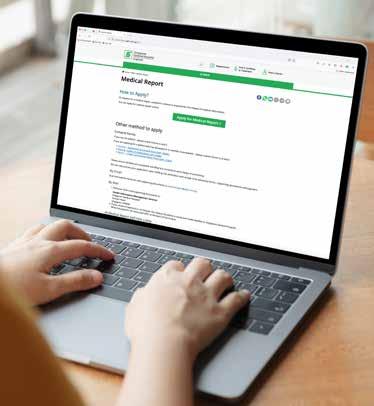
Patients under the age of 21 can apply for a medical report with the consent of their parent or legal guardian. For a report for deceased or mentally incompetent patients, written consent from their authorised representative or all their immediate next-of-kin is needed.

that since October 2021, Sengkang General Hospital’s (SKH) speech therapists have been wearing a transparent mask to aid in ease of communication with patients who have speech, hearing and swallowing disorders?
SKH developed this mask in partnership with the Agency for Science, Technology and Research and local mask producer Forever Family. The transparent mask allows patients to view the therapists’ lip movements during therapy sessions. The mask does not only meet the stringent protective standards required in medical settings, it also has an anti-fog shield to maintain visibility. This way, patients are able to model mouth movements, sounds and words more easily, compared to when a therapist wears a regular surgical mask.

19 DidYouKnow
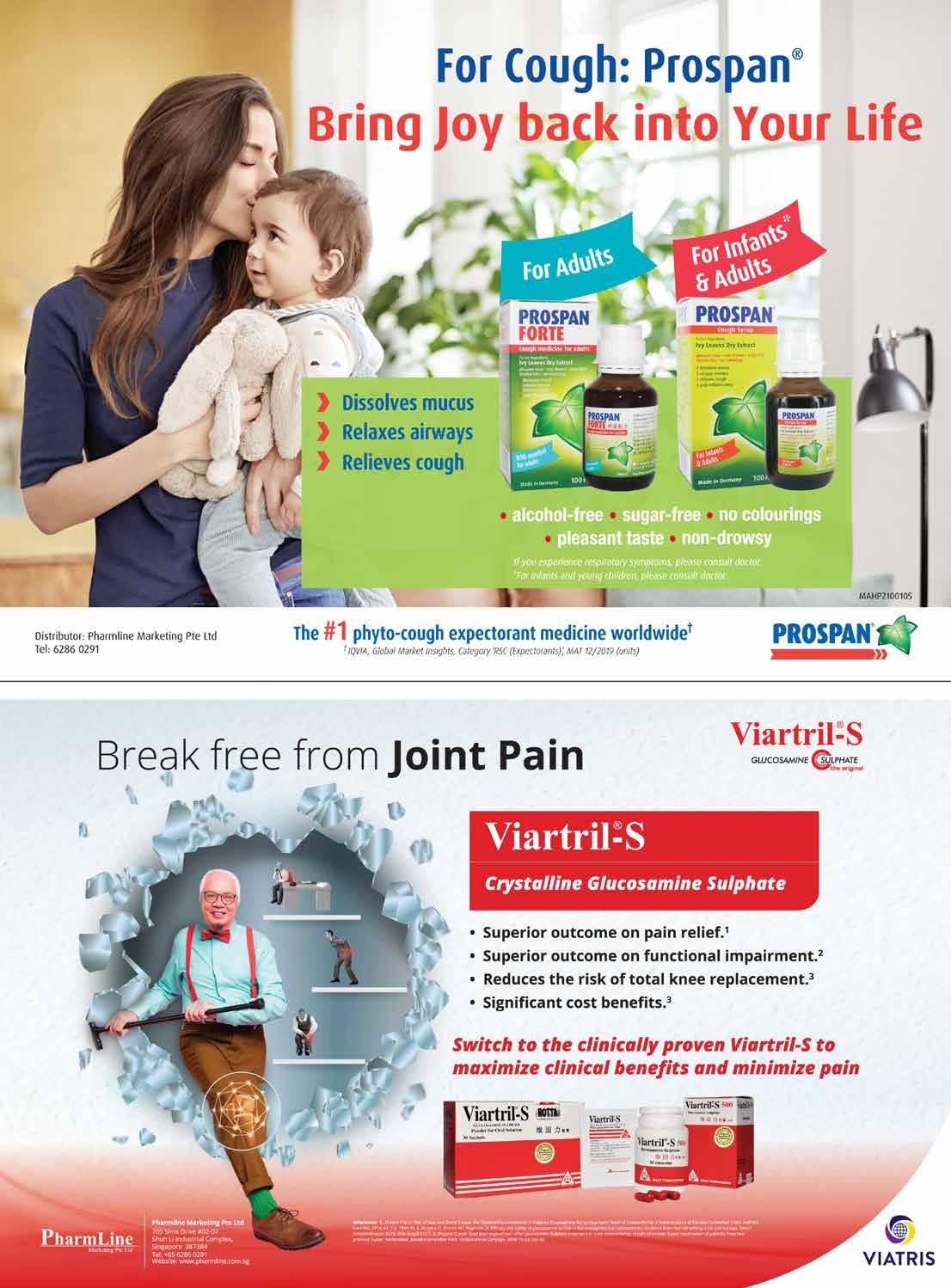











































 By Goh Bee Lian, with information provided by Associate Professor
Goh, Senior Consultant, Department of Gastroenterology and Hepatology, SGH
By Goh Bee Lian, with information provided by Associate Professor
Goh, Senior Consultant, Department of Gastroenterology and Hepatology, SGH
 by Puvanes Balakrishnan
by Puvanes Balakrishnan

 by Sol E Solomon
by Sol E Solomon


 by SK Lim
by SK Lim












